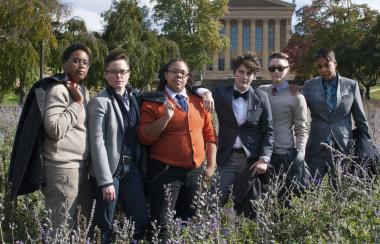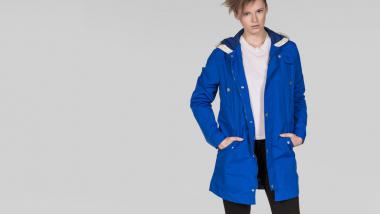December 18, 2014 - 22:49

Amelia Brady-Cole
Identity Matters 360
Dalke, Lindgren, and Nath
December 19th 2014
Stratification and Erasure of Intersectional Identities
"The research on fashionable styles of veiling has sought to understand what it means for women to wear veiling fashion and how they negotiate conflicting ideals of piety, beauty, modesty, femininity, and national identity in a variety of contexts. Fashionably veiled women constantly navigate the multiple social and cultural signification of their clothing, which has been variably associated with politics, aesthetics, fashion, and class status. Wearers of the styles invest considerable time, energy, and money in their clothing, headscarves, and accessories. At the same times, the fashion industry and self-identified Muslim women's lifestyle magazines devise strategies to turn Islamic virtue into economic value and vice versa” (Gokariksel and Secor, 181). The triangular relationship between the subject, the observer, and the gaze is present in many art forms including fashion. The desire to be seen in a certain light inspires magnification of certain traits, and minimization of others. Intersecting political and cultural markers complicate this relationship, especially in marginalized groups. In this way, fashion can be a rich art form with which to examine intersectional identities. Muslim women’s fashion has been commodified in the fashion industry, as have the fashion trends of other identities. This is especially dangerous for marginalized groups as it commercializes and trivializes personal expression.
Autostraddle’s writer, dapperq wrote an article on 6 queer and trans individuals. This article is part of a larger project that documents the fashion inspiration of queer women and trans people from all over the country. The models bring their own clothes to the fashion shoots. They aren’t stylized or molded to someone else’s idea of how they should look. For this particular shoot in Philadelphia, several of the models expressed pride in their visibility as queer people. They wanted their experience to be seen, and fashion is one of the main ways they choose to become visible in their queer identities. Part of the article is spent discussing what they got from being part of this photo shoot. Tiffany Thompson said, “It was an honor because I really didn’t consider myself to be that dapper, but I have always took pride in making sure my outfit was on point! But mostly it is important to see masculine brown bois who are as fashion role models. I am a curvy person with a large chest and what looks good on some people does not always look the same for me. I have learned through trial and errors the tricks that make me feel sexy, comfortable, and stylish and I hope that someone else will see my pics, see something in themselves and get inspired” (Autostraddle). Never in the description of the project does it say anything about needing to look “dapper,” a label that has, in the last few years, become synonymous with masculine-presenting queer. The styles that are recognized as queer are typically more similar to men’s styles, and the one that has been adopted by many queer women often includes bowties, button-downs, and oxfords: the look that has been coined “dapper queer”. Sonny Oram of Qwear.com says that the “dapper” or “boi” style has become the go-to queer style that many young queer women experiment with when they’re first coming out and understanding their sexual identities because it’s common and relatively simple to recreate (Oram). It’s what’s being mass-produced right now, and it’s how queer women are represented in the media.

Similar to how Gokariksel and Secor talk about veiling fashion, queer fashion is something that people put a lot of time, energy, and money into perfecting. There’s a sense in the queer community that to be recognized as queer enough, or legitimately queer, you have to attain the dominant dapper queer aesthetic. The fashion industry, like any other industry focused on making a profit, works in two ways. The first is by recognizing demands in the marketplace and responding by supplying customers with what they ask for. The LGBTQ community has used the internet as a platform for conversation, connection, and expression in the last decade, and because of the new LGBTQ presence on the internet, the fashion industry has responded with clothing to fit their demands. The second way the fashion industry makes money is by creating the demand they’re already prepared to fill. By broadcasting certain images and aesthetics over others, their audience becomes reliant on those images and what they can find in stores will match up with what they see in magazines and on television. Though like any community, queer fashion trends evolve and change, currently, the market has been geared toward accommodating queers who present masculinely.
This means that people who want that part of their identities to be visible have to play by the rules set by the mainstream culture in order to be recognized by the mainstream and counter cultures. Part of being queer is being able to mess with normative standards (What Is Queer Fashion?). By challenging the norm and creating something new and interesting, you’re expressing part of your identity that doesn’t come from a commercial corporation. The mass production of the dapper style means two things for queer people. The first is that any way of expressing queerness other than with dapper clothes is not recognized as legitimate, and the second is that dapperness within queer culture becomes stratified. It’s like a competition to see who can be queerer: the most gay and the most stylish. In order to attain the aesthetic that has been created for queers they have to buy the clothing that the gayest and most stylish icons wear. Blogs like Qwear and Dapper Q have contributed to the erasure of other forms of queer expression by promoting stores that sell only expensive masculine-of-center clothing. If your body doesn’t meet the long, slender, boyish standards presented on these websites, how could you hope to be visibly queer in your community?


Shirts that start at $150 and go up to $700 are available to only a small subset of the queer population. Wealthy people who have that kind of money to spend on clothing are able to attain the aesthetic necessary to be seen as “queer enough,” while those who cannot support that kind of lifestyle or who don’t identify as masculine of center are not allowed access into the cool queer kids club. Qwear is said to use fashion as an expressive tool to strengthen the queer community and that by focusing on styles for queer women and trans people, their team offers fashion advice and provides style inspiration. They say “Our inspiration provides a space void of the strict beauty standards of mainstream media and works to celebrate all bodies, abilities, races, and identities” (Qwear). How can that be true when the majority of the websites they sponsor cater to wealthy white people? It seems that social awareness may be fashionable, and as a marginalized group the queer people running Qwear felt obligated to declare their acceptance of all identities, but in practice their scope is very limited.
One of the more popular online clothing stores for queer fashion, called Androgyny, makes menswear adapted to fit a woman’s body while masking her curves, and providing a structured and angled aesthetic. Their overly expensive products have everything their customers crave. The high quality of their products, and the fact that they are one of very few suppliers of this community’s demands means that they are able to hike up their prices as much as they want to. In a marketing campaign, they made a video that shows the struggles many queer women experience when trying to find clothes that are not too bulky and boxy but also not too form fitting and curved. Across the screen at the end of the video it states, "Inspiring personal confidence one shirt at a time” (Androgyny). That confidence can only be inspired in people with the right kind of intersecting identities. Wealthy, masculine queer women can have their sexual orientation and gender identity recognized and legitimized while poor queer women or queer women who choose to present more femininely have their sexuality and gender identity questioned and categorized as lesser.
The stratification of marginalized identities mirrors the stratification of any other identities. Rivalries between subsets of an identity, form in order for members to be acknowledged as the “most” of their identity. This competition likely stems, at least in part, from the prioritization of vertical identities over horizontal ones. Because queerness is not passed down through familial lines, it’s seen as acquired outside of kinship. Because their nonnormativity often separates queer people from their families and mainstream culture, the desire to completely fit into the queer community and be the most “normal” of queers, is a struggle many people face. Similar to women who veil, there’s often discord between two or more of their intersecting identities, and that tension sometimes creates the need to separate from one identity and adhere more devoutly to another.
Works Cited
"Androgynous Fashion - Tomboy Style - Androgyny." Androgyny. N.p., n.d. Web. 18 Dec. 2014. <http://www.wearandrogyny.com/#>.
Androgyny Teaser. Vimeo. N.p., n.d. Web. 16 Dec. 2014. <http://vimeo.com/76505878>.
"DapperQ • Gender Queer Masculine Fashion and Style." DapperQ. N.p., n.d. Web. 16 Dec. 2014. <http://www.dapperq.com/>.
Dapperq. "He Said/We Said: In the City of Brotherly Love." Autostraddle. N.p., 05 Dec. 2014. Web. 18 Dec. 2014. <http://www.autostraddle.com/he-saidwe-said-in-the-city-of-brotherly-love-267820/>.
Oram, Sonny. "Interview on Queer Fashion Blogging and Industry with Sonny." RSS. Http://www.qwearfashion.com/home/interview-on-queer-fashion-blogging-and-industry-with-sonny, 9 July 2014. Web. 15 Dec. 2014.
"Press." Qwear. N.p., n.d. Web. 18 Dec. 2014. <http://www.qwearfashion.com/press/>.
What Is Queer Fashion. YouTube. N.p., 31 Dec. 2013. Web. 16 Dec. 2014. <https://www.youtube.com/watch?v=zoXpqNcCHR0#t=337>.
